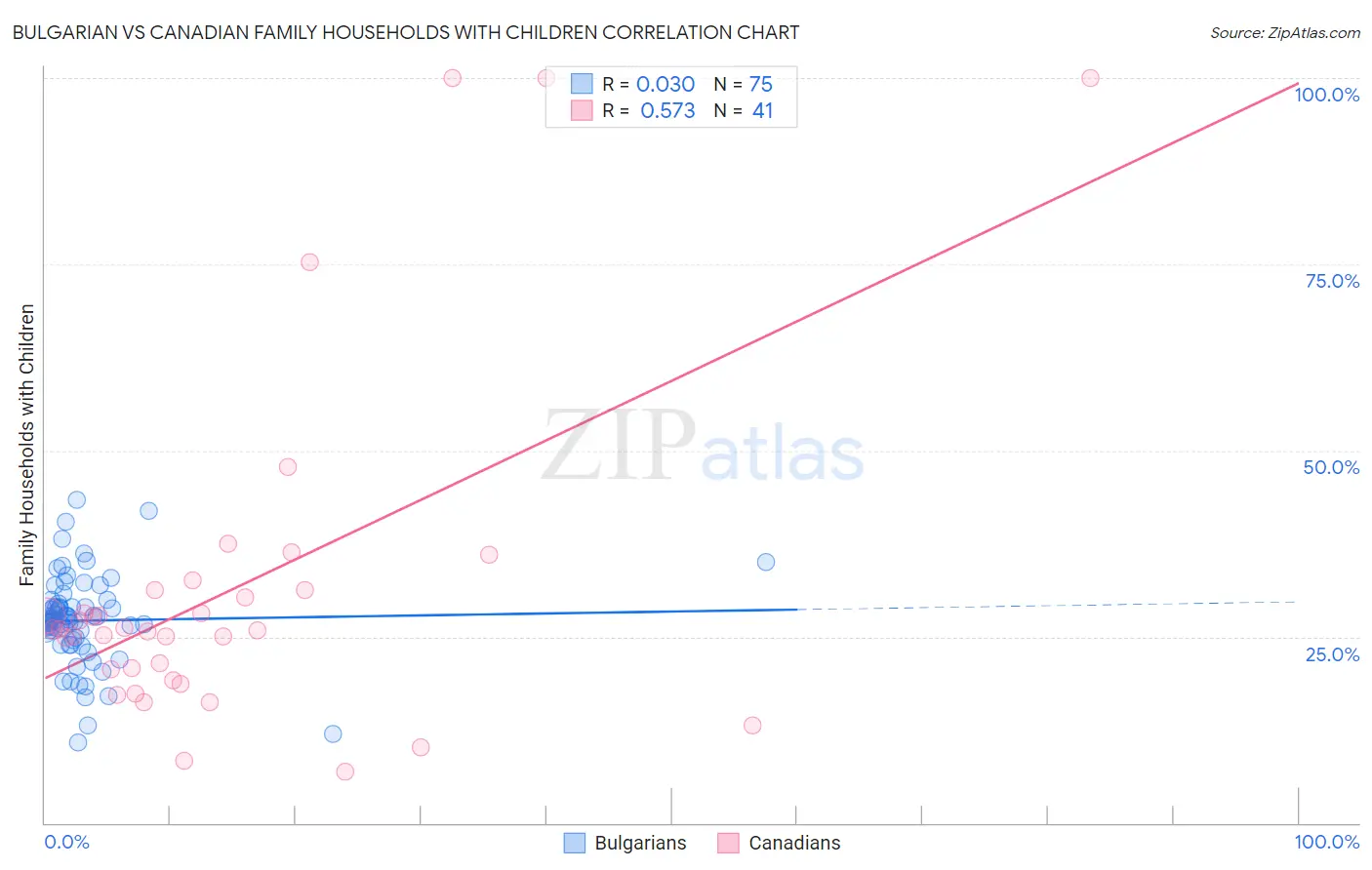Bulgarian vs Canadian Family Households with Children
COMPARE
Bulgarian
Canadian
Family Households with Children
Family Households with Children Comparison
Bulgarians
Canadians
27.0%
FAMILY HOUSEHOLDS WITH CHILDREN
5.8/ 100
METRIC RATING
230th/ 347
METRIC RANK
27.1%
FAMILY HOUSEHOLDS WITH CHILDREN
7.5/ 100
METRIC RATING
225th/ 347
METRIC RANK
Bulgarian vs Canadian Family Households with Children Correlation Chart
The statistical analysis conducted on geographies consisting of 205,477,079 people shows no correlation between the proportion of Bulgarians and percentage of family households with children in the United States with a correlation coefficient (R) of 0.030 and weighted average of 27.0%. Similarly, the statistical analysis conducted on geographies consisting of 437,085,688 people shows a substantial positive correlation between the proportion of Canadians and percentage of family households with children in the United States with a correlation coefficient (R) of 0.573 and weighted average of 27.1%, a difference of 0.16%.

Family Households with Children Correlation Summary
| Measurement | Bulgarian | Canadian |
| Minimum | 10.8% | 6.9% |
| Maximum | 43.4% | 100.0% |
| Range | 32.7% | 93.1% |
| Mean | 27.2% | 31.4% |
| Median | 27.3% | 26.0% |
| Interquartile 25% (IQ1) | 24.6% | 19.9% |
| Interquartile 75% (IQ3) | 29.5% | 31.3% |
| Interquartile Range (IQR) | 4.9% | 11.4% |
| Standard Deviation (Sample) | 6.1% | 22.5% |
| Standard Deviation (Population) | 6.0% | 22.2% |
Demographics Similar to Bulgarians and Canadians by Family Households with Children
In terms of family households with children, the demographic groups most similar to Bulgarians are Luxembourger (27.0%, a difference of 0.030%), Immigrants from Caribbean (27.0%, a difference of 0.050%), Yugoslavian (27.0%, a difference of 0.070%), Czechoslovakian (27.0%, a difference of 0.080%), and Tsimshian (27.0%, a difference of 0.080%). Similarly, the demographic groups most similar to Canadians are Czechoslovakian (27.0%, a difference of 0.080%), Tsimshian (27.0%, a difference of 0.080%), Scottish (27.0%, a difference of 0.080%), German (27.1%, a difference of 0.090%), and Immigrants from Caribbean (27.0%, a difference of 0.11%).
| Demographics | Rating | Rank | Family Households with Children |
| U.S. Virgin Islanders | 12.1 /100 | #217 | Poor 27.1% |
| Greeks | 11.4 /100 | #218 | Poor 27.1% |
| Immigrants | Japan | 10.7 /100 | #219 | Poor 27.1% |
| Austrians | 9.9 /100 | #220 | Tragic 27.1% |
| New Zealanders | 9.6 /100 | #221 | Tragic 27.1% |
| Paraguayans | 9.4 /100 | #222 | Tragic 27.1% |
| Pima | 9.2 /100 | #223 | Tragic 27.1% |
| Germans | 8.7 /100 | #224 | Tragic 27.1% |
| Canadians | 7.5 /100 | #225 | Tragic 27.1% |
| Czechoslovakians | 6.6 /100 | #226 | Tragic 27.0% |
| Tsimshian | 6.6 /100 | #227 | Tragic 27.0% |
| Scottish | 6.5 /100 | #228 | Tragic 27.0% |
| Immigrants | Caribbean | 6.3 /100 | #229 | Tragic 27.0% |
| Bulgarians | 5.8 /100 | #230 | Tragic 27.0% |
| Luxembourgers | 5.5 /100 | #231 | Tragic 27.0% |
| Yugoslavians | 5.1 /100 | #232 | Tragic 27.0% |
| Immigrants | Italy | 5.0 /100 | #233 | Tragic 27.0% |
| Immigrants | Germany | 4.4 /100 | #234 | Tragic 27.0% |
| Immigrants | Morocco | 4.2 /100 | #235 | Tragic 27.0% |
| Cape Verdeans | 3.6 /100 | #236 | Tragic 26.9% |
| Immigrants | Netherlands | 3.5 /100 | #237 | Tragic 26.9% |